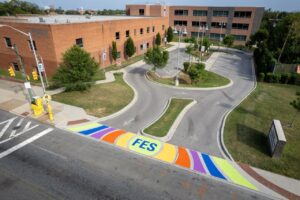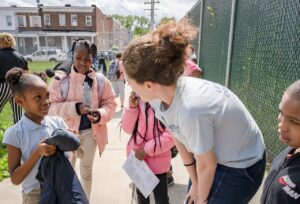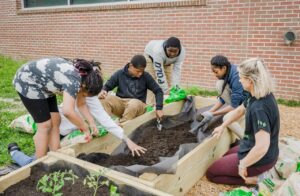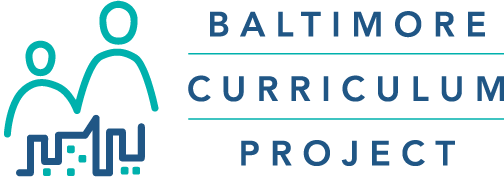Frederick Elementary School (FES) has been a cornerstone of education in West Baltimore since 1983, when it was originally built as a traditional public elementary school. Over the years, FES faced various challenges, including aging infrastructure, fluctuating enrollment numbers, and the need for enhanced academic resources. Despite these obstacles, the school remained a vital institution for the community.
A School Reborn
 In 2016, as part of the Baltimore City Public Schools’ 21st Century School Building Plan, the school board decided to merge FES with Samuel F.B. Morse Elementary School. The goal was to consolidate resources and better serve the community’s educational needs. At the same time of the merger, FES transitioned to a neighborhood conversion public charter school under the Baltimore Curriculum Project (BCP).
In 2016, as part of the Baltimore City Public Schools’ 21st Century School Building Plan, the school board decided to merge FES with Samuel F.B. Morse Elementary School. The goal was to consolidate resources and better serve the community’s educational needs. At the same time of the merger, FES transitioned to a neighborhood conversion public charter school under the Baltimore Curriculum Project (BCP).
Additionally, the school received a newly renovated, state-of-the-art building. Watch the video that highlights the school’s modern classrooms, collaborative learning spaces, and dedicated areas for physical education, music, science labs, art, media, and computer labs.
More than a facility upgrade, this investment signaled a new beginning. Under the leadership of BCP and founding principal Harold S. Henry, Jr. (now BCP’s Chief of Schools), FES adopted a mission to prepare students as future leaders who use wisdom to solve complex problems and uplift their communities. The school’s values—wisdom, leadership, and community—are symbolized by Ghanaian Adinkra icons displayed throughout the building, serving as daily reminders of cultural pride and shared purpose.
A Catalyst for Community Revitalization
 FES sits in Baltimore’s 21223 ZIP code—home to Millhill, Carrollton Ridge, and Shipley Hill—where residents face low median incomes, high unemployment, and a large concentration of vacant properties. But as a community school, FES is actively helping to shift the narrative.
FES sits in Baltimore’s 21223 ZIP code—home to Millhill, Carrollton Ridge, and Shipley Hill—where residents face low median incomes, high unemployment, and a large concentration of vacant properties. But as a community school, FES is actively helping to shift the narrative.
FES, now led by Tetra Jackson, Principal, embraces a holistic model that goes beyond academics to meet the social, emotional, and economic needs of students and their families. This work is powered by a partnership with Bon Secours Community Works, the school’s lead community partner. Together, the school and partner organizations provide wraparound services that families in West Baltimore depend on, including:
- Health and Wellness Resources: Families have access to health screenings, mental health counseling, and referrals to local medical providers. The school hosts wellness fairs and nutrition programs to address community health disparities.
- Family Support Services: Through case management, parent workshops, and financial coaching, families receive tools to build stability and long-term security. Assistance with housing, employment, and benefits navigation helps ease the daily burdens many parents face.
- Restorative Practices: FES uses restorative circles and conflict resolution strategies to strengthen relationships between students, teachers, and families. This creates a positive school climate and helps reduce suspensions while teaching problem-solving and empathy.
- After-School and Enrichment Programs: From STEM and robotics to culinary arts, theater, and photography, Frederick offers free after-school programs that allow students to explore interests and talents. These programs are open to all children in the neighborhood—not just enrolled students—removing barriers to enrichment opportunities.
- Community Engagement: The school regularly opens its doors for family nights, resource fairs, and neighborhood meetings, creating a safe and welcoming gathering space in a community that has historically lacked access to public amenities.
Part of a Larger Movement
 The reinvestment in FES is not happening in isolation. It is part of a larger set of initiatives aimed at reversing decades of disinvestment in West Baltimore.
The reinvestment in FES is not happening in isolation. It is part of a larger set of initiatives aimed at reversing decades of disinvestment in West Baltimore.
- The Baltimore Vacants Reinvestment Initiative (BVRI) aims to remove blight, stabilize blocks, and create pathways for new housing and green spaces.
- The School-Centered Neighborhood Investment Initiative (SCNII), led by the Maryland Philanthropy Network, is aligning resources with the city’s 21st Century Schools program. The idea is simple but powerful: when schools like FES are modernized, they can anchor neighborhood renewal—attracting homeowners, sparking small business growth, and restoring pride.
West Baltimore has endured decades of disinvestment and disruption, from job loss to the scars left by the abandoned “Highway to Nowhere.” Change will not come overnight. But the story of Frederick Elementary shows what is possible when schools are positioned as neighborhood catalysts—centers of both learning and renewal.
The rebirth of Frederick Elementary is more than one school’s transformation. It is a glimpse of what reinvestment can mean for an entire community: a place where children succeed, families feel supported, and neighborhoods begin to thrive again.
